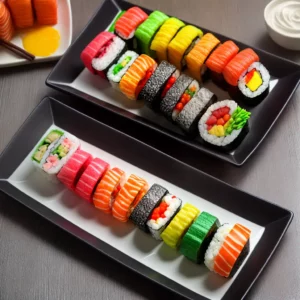How to Chop an Onion
Have you ever wondered how to chop an onion without shedding a tear? In this step-by-step guide, I will walk you through the process of chopping an onion like a master chef. By mastering the art of onion chopping, you’ll be able to enhance your culinary skills and create delicious meals with ease.
How to Chop an Onion – Key Takeaways:
- Start by cutting off the stem end and a shallow cut off the root end of the onion.
- Peel back the onion skin and cut the onion in half from top to bottom.
- Make lengthwise cuts into the onion and then cross-wise cuts.
- Hold the onion firmly and make vertical crosswise slices.
- You can also mince the onion by chopping it finely.
- To avoid tears, use a sharp knife and minimize exposure to the cut sides of the onion.
- Store chopped onions in a zip-top bag or airtight container in the refrigerator for up to 5 days.
Now that you have the basic steps down, let’s dive into each section in more detail to master the art of onion chopping. With practice and patience, you’ll soon be chopping onions like a pro! See how to chop shallots here.
The Importance of Proper Technique in Onion Chopping
Proper technique is crucial when it comes to chopping onions, as it ensures that you achieve uniform and evenly cut pieces every time. By following the correct technique, you can not only enhance the visual appeal of your dishes but also ensure that the onion cooks evenly, resulting in a more harmonious flavor profile.
When chopping an onion, it is important to start with a sharp knife and a stable cutting board. A sharp knife allows for clean cuts, reducing the chances of crushing or bruising the onion. A stable cutting board provides a secure surface to work on, minimizing the risk of accidents.
To begin, cut off about 1/2 inch from the stem end and make a shallow cut off the root end. This creates a stable base for the onion. Then, cut the onion in half from top to bottom and peel back the onion skin. This exposes the flesh of the onion and makes it easier to handle.
| Step | Description |
|---|---|
| 1 | Trim ends and peel |
| 2 | Make lengthwise cuts |
| 3 | Make crosswise cuts |
| 4 | Chop or mince as desired |
Next, make lengthwise cuts into the onion, being careful not to cut all the way through. These cuts should run parallel to the cutting board and evenly spaced. Then, make crosswise cuts perpendicular to the lengthwise cuts. The width of these cuts will determine the size of the onion pieces.
Finally, to achieve finely diced onions, continue to hold the onion firmly and make vertical crosswise slices, followed by mincing the onion by chopping it finely. This technique is commonly used in recipes that require smaller pieces of onion, such as salsas or dressings.
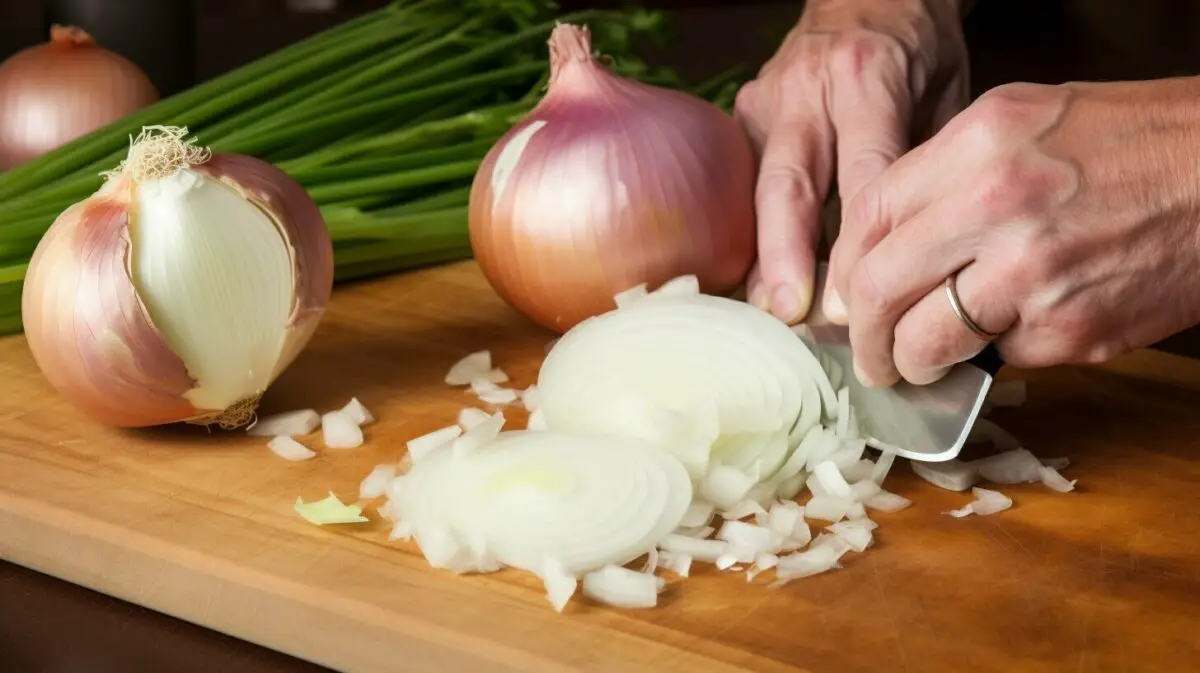
Remember, practice makes perfect when it comes to mastering the art of onion chopping. With time and experience, you will develop your own preferred techniques and become more efficient in the kitchen. So put on your chef’s hat, grab a sharp knife, and let’s start chopping!
Essential Tools for Onion Chopping
To chop an onion with finesse, you’ll need two must-have tools – a sharp knife and a sturdy cutting board. Let me explain why these tools are essential to achieve the best results in your onion chopping endeavors.

| Tool | Description |
|---|---|
| Sharp Knife | A sharp knife is crucial for clean and precise cuts. Dull knives can crush the onion instead of cleanly slicing through it, resulting in uneven pieces. Invest in a high-quality, sharp knife that allows you to maneuver effortlessly and maintain control while chopping. |
| Cutting Board | A sturdy cutting board provides a stable surface for chopping. It should be large enough to accommodate the size of the onion and have enough grip to prevent slipping. Opt for a cutting board made of durable materials such as wood or plastic, as they are easier to clean and won’t dull your knife as quickly. |
Now that you understand the importance of these tools, let’s move on to the next section and learn how to prepare the onion for chopping.
Preparing the Onion for Chopping
Before diving into the chopping process, it’s important to properly prepare the onion by peeling away the outer skin and trimming the root and stem ends. Start by cutting off about 1/2 inch from the stem end, creating a flat surface to work with. Then, make a shallow cut off the root end, removing just enough to expose the onion layers. This will help stabilize the onion and prevent it from rolling while you chop.
To peel the onion, gently pull back the thin layer of papery skin from the cut stem end. As you peel, the skin should easily come off, revealing the layers underneath. Continue peeling until all the outer skin has been removed, taking care not to remove too much of the onion itself.
Once the onion is peeled, it’s ready for chopping. The trimmed root end provides a stable base, while the cut stem end creates a flat surface for easy slicing. With the onion properly prepared, you’re now ready to move on to the next steps in the chopping process.
| Tip: | For a visual guide on peeling and trimming an onion, refer to the image below: |
|---|---|
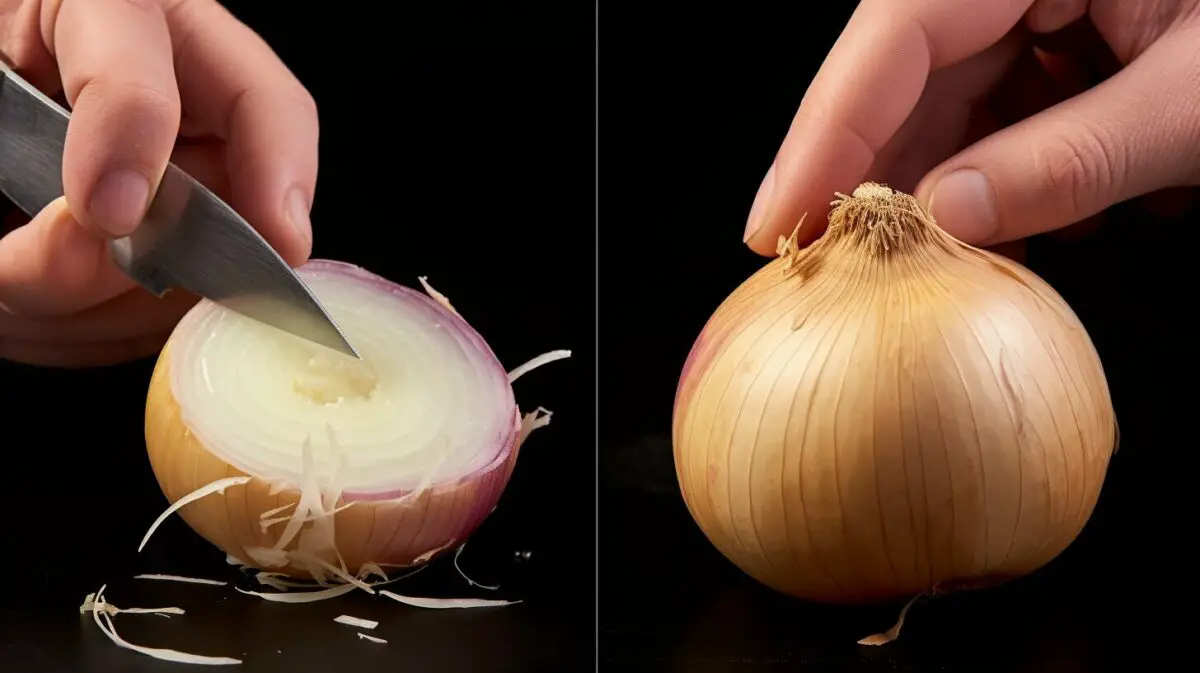 |
Making Lengthwise Cuts
With the onion prepared, it’s time to make lengthwise cuts that will serve as the framework for the crosswise cuts. This step is crucial in achieving the desired onion shape and texture for your recipes. By following these simple steps, you’ll be on your way to chopping onions like a pro.
To start, place one of the onion halves flat-side down on the cutting board. With a sharp knife, make vertical lengthwise cuts, starting from the root end to the stem end. The size of the cuts will depend on the thickness you desire for your recipe; thinner cuts will result in smaller onion pieces, while thicker cuts will yield larger pieces. Remember to use a rocking motion with the knife to maintain control and stability throughout the process.
Continue making lengthwise cuts until you reach the other end of the onion. Take care to keep the onion halves intact and avoid cutting all the way through. Once the lengthwise cuts are complete, you are ready to move on to the next step: the crosswise cuts.

With the lengthwise cuts made, it’s time to create the desired onion shape by making crosswise cuts. These cuts will determine whether you achieve onion rings, half-moons, wedges, julienne, or brunoise. To make crosswise cuts, hold the onion firmly and make vertical crosswise slices perpendicular to the lengthwise cuts.
For onion rings, make wider crosswise cuts, resulting in circular slices. For half-moons, make narrower crosswise cuts, creating semi-circular slices. Wedges can be achieved by making diagonal crosswise cuts, resulting in triangular pieces. Julienne and brunoise require thinner crosswise cuts, producing matchstick-like or finely diced onions.
Take your time and adjust the thickness of the crosswise cuts to suit your specific recipe or personal preference. By mastering the art of crosswise cuts, you’ll be able to create visually appealing and evenly cooked onion pieces in your dishes.
Crosswise Cuts and Slices
Once the lengthwise cuts are complete, it’s time to move on to the crosswise cuts and slices, which will determine the final shape of your onion pieces. There are various techniques you can employ to achieve different onion shapes, such as rings, half-moons, wedges, julienne, or brunoise.
To create rings, simply make perpendicular cuts to the lengthwise cuts you’ve already made. The thickness of the rings can be adjusted according to your preference or recipe requirements. For half-moons, make diagonal cuts across the onion, resulting in crescent-shaped pieces.
Wedges are achieved by cutting the onion in half horizontally and then making radial cuts, similar to cutting a pizza. For julienne cuts, stack two or three slices together and make crosswise cuts to create thin, matchstick-like pieces. Finally, brunoise involves making small, uniform cubes by finely dicing the onion.
| Cut Shape | Technique |
|---|---|
| Rings | Perpendicular cuts to lengthwise cuts |
| Half-moons | Diagonal cuts across the onion |
| Wedges | Horizontal cut and radial cuts |
| Julienne | Stack slices and make thin crosswise cuts |
| Brunoise | Finely dice the onion |
Experiment with different cutting techniques to achieve the desired shape and texture for your dishes. Remember to always use a sharp knife for clean and precise cuts. With practice, you’ll develop the skills to chop onions like a pro.
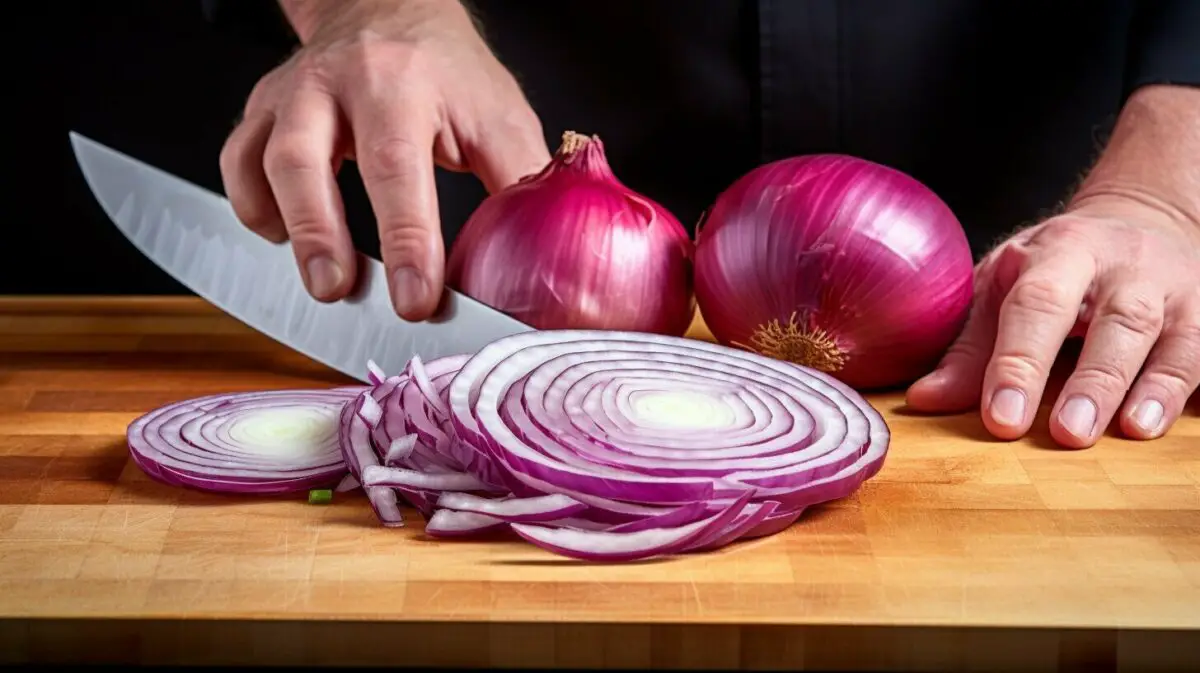
Remember, practice makes perfect when it comes to chopping onions. So don’t be afraid to experiment and find the techniques that work best for you. Happy chopping!
Achieving Finely Diced Onions
For recipes that call for finely diced onions, mastering the art of mincing is essential. This technique allows you to create small, uniform pieces that blend seamlessly into your dishes, adding flavor and texture. Here’s a step-by-step guide on how to achieve finely diced onions:
- Begin by peeling the onion and cutting off about 1/2 inch from the stem end and a shallow cut off the root end. This creates a stable base for chopping.
- Next, cut the onion in half from top to bottom and peel back the onion skin. This exposes the layers of the onion, making it easier to slice and dice.
- Hold one half of the onion firmly and make lengthwise cuts into the onion, starting from the stem end. The closer you space the cuts, the finer the resulting dice will be.
- Now, make cross-wise cuts across the onion, slicing perpendicular to the lengthwise cuts. Again, the closer the spacing, the finer the dice.
- If you prefer an even smaller dice, hold the onion firmly and make vertical crosswise slices, resulting in tiny pieces.
- If your recipe calls for finely minced onion, simply continue chopping the onion into smaller pieces until you reach the desired texture.
Remember, using a sharp knife is crucial for achieving finely diced onions. A dull knife can crush the onion, leading to uneven cuts and loss of flavor. Keep your knife sharp and your strokes steady for the best results.
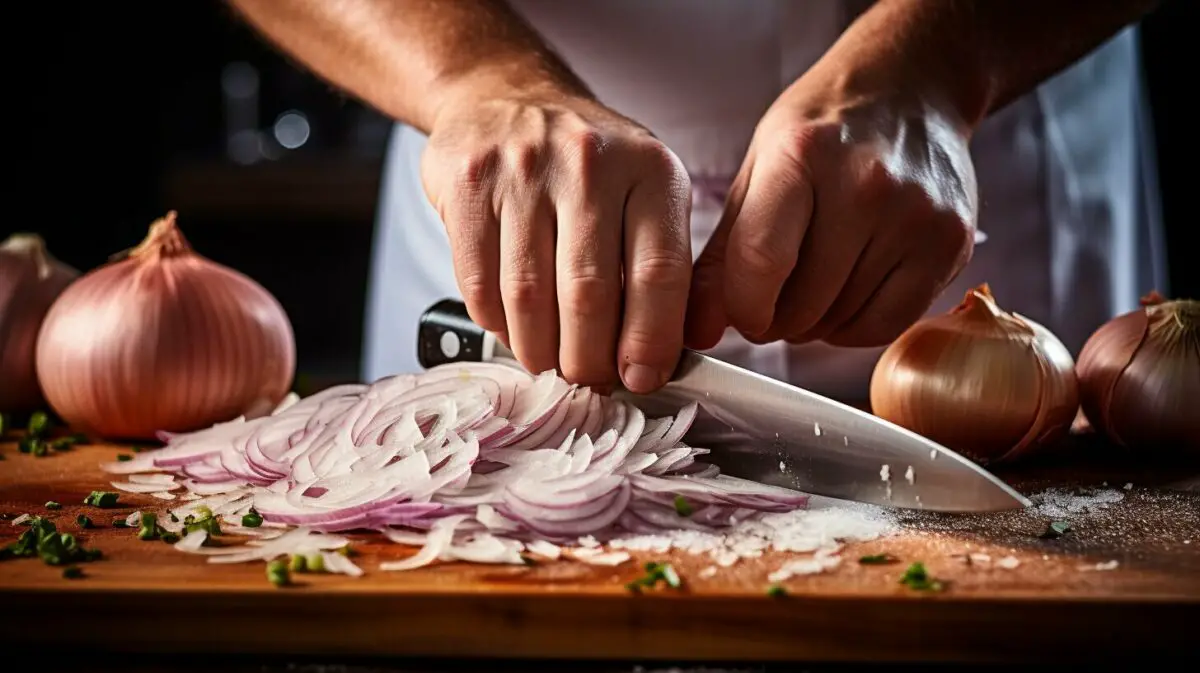
“Finely diced onions add a burst of flavor to any dish. The small, uniform pieces distribute the onion’s aroma and taste evenly. It’s like a delightful surprise in every bite!” – Chef John Doe
Once you have achieved finely diced onions, you can incorporate them into a variety of recipes, from soups and sauces to salads and stir-fries. Store any unused diced onions in a zip-top bag or airtight container in the refrigerator for up to 5 days, ensuring they remain fresh and flavorful for future culinary creations.
| Dicing Technique | Description |
|---|---|
| Finely diced | Small, uniform pieces approximately 1/8 inch in size |
| Minced | Very fine pieces, often achieved through repeated chopping or using a food processor |
| Chopped | Larger, irregular pieces that are perfect for sautéing or using in stews |
Mastering Onion-Chopping Techniques to Avoid Tears
Chopping onions often leads to teary eyes, but fear not – there are ways to minimize the tears and make your chopping experience more enjoyable. Understanding the science behind tear-inducing sulfur compounds and employing a few handy techniques can help you master the art of onion chopping while keeping those tears at bay. Let’s explore some strategies to make your onion chopping sessions tear-free.
Use a Sharp Knife and Quick Chops
When it comes to chopping onions, a sharp knife is your best friend. A dull knife crushes the onion cells, releasing more of those tear-inducing compounds. A sharp knife, on the other hand, slices through the onion with minimal damage and less exposure to the compounds. So, sharpen your knife before you start chopping to make the process more efficient and tear-free.
Additionally, adopting a quick chopping technique can further reduce exposure to the onion’s cut sides. The longer you take to chop an onion, the more time those compounds have to release and irritate your eyes. Try to work swiftly, using fluid motions, to minimize the time your eyes are exposed and keep the tears away.
Create a Tear-Free Environment
Creating a tear-free environment while chopping onions can make a world of difference. Proper ventilation can help dissipate the compounds that cause tears, so switch on a fan or open a window to improve airflow in your kitchen. Alternatively, you can use a damp paper towel or a slice of bread near your chopping area to absorb the compounds and reduce their dispersal.
If you’re particularly sensitive to onion fumes, consider wearing goggles while chopping. They may seem like a quirky addition to your kitchen attire, but they can effectively shield your eyes from the irritants, leaving you tear-free and able to focus on perfecting your onion chopping technique.
Remember, mastering onion-chopping techniques takes practice, but with these tips and tricks, you’ll be well on your way to becoming a tear-free onion-chopping pro. So, grab your sharp knife, create a tear-free environment, and enjoy the process of transforming an ordinary onion into beautiful, perfectly chopped pieces for your culinary creations.
| Tear-Free Onion-Chopping Techniques | |
|---|---|
| Use a sharp knife | The sharper the knife, the cleaner the cuts, and the less irritation. |
| Quick chopping | Work swiftly to minimize exposure to tear-inducing compounds. |
| Proper ventilation | Open a window or use a fan to improve airflow and disperse the compounds. |
| Protective goggles | A quirky but effective way to shield your eyes from irritants. |
Creating a Tear-Free Environment
To create a tear-free onion-chopping experience, it’s essential to take certain precautions and create an environment that minimizes onion-induced tears. Here are some tips to help you achieve a tear-free chopping process:
- Ventilate the area: Ensure proper ventilation in your kitchen by opening windows or using a fan. This will help disperse the onion’s tear-inducing sulfur compounds.
- Use a fan: Position a fan near your chopping area, directing the airflow away from your face. The fan will help blow away the onion’s volatile compounds that cause tears.
- Wear goggles: Consider wearing protective goggles to shield your eyes from onion fumes. Goggles create a physical barrier, preventing the irritating compounds from reaching your eyes.
By implementing these measures, you can create a tear-free environment that allows you to chop onions without discomfort. Remember, when it comes to onions, a little preparation can go a long way in ensuring a pleasant and tear-free chopping experience.
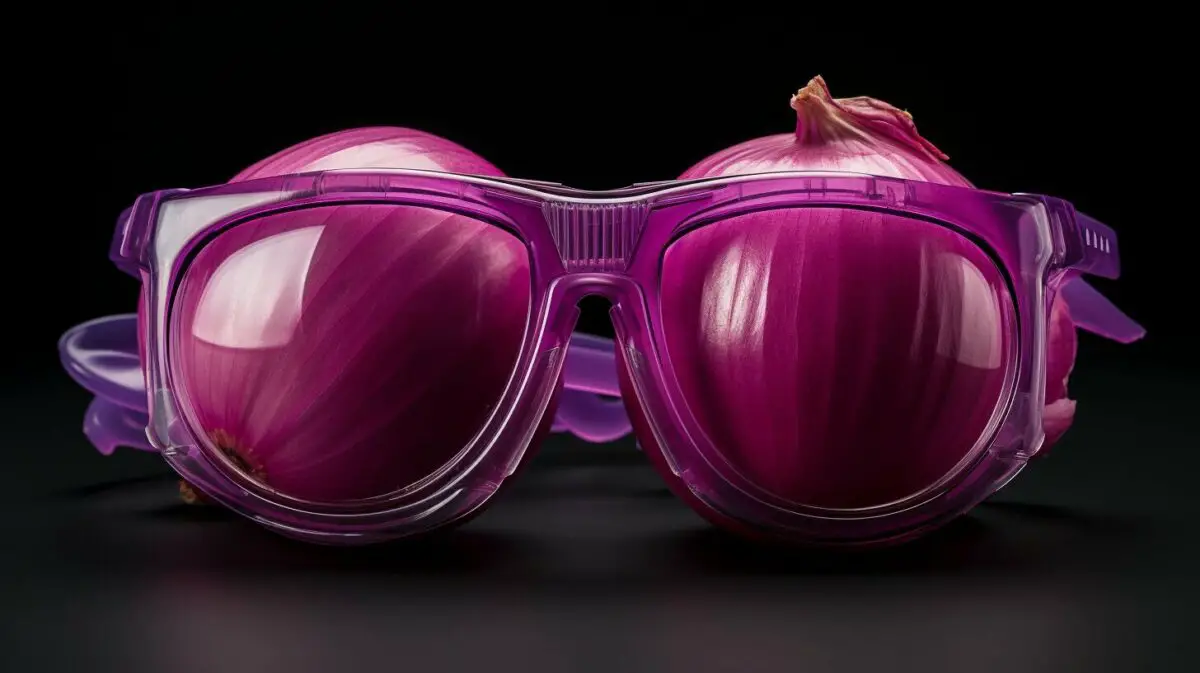
| Precautions | Benefits |
|---|---|
| Ventilate the area | Minimizes the concentration of tear-inducing compounds in the air |
| Use a fan | Blows away onion fumes and reduces their exposure |
| Wear goggles | Creates a physical barrier, protecting the eyes from onion-induced irritation |
Storing Chopped Onions
Once you’ve chopped your onions, it’s crucial to store them properly to maintain their freshness and flavor. Proper storage not only helps prevent spoilage but also allows you to have pre-chopped onions readily available for your cooking needs. Here are some tips on how to store chopped onions:
- Refrigerate: Chopped onions should be stored in the refrigerator to keep them cool and slow down the enzymatic reactions that can cause them to spoil. Place the chopped onions in a sealed container or a zip-top bag to prevent them from absorbing odors from other foods in the fridge.
- Use an airtight container: An airtight container helps to maintain the moisture content of the chopped onions, keeping them from drying out. This helps preserve their flavor and texture for a longer period.
- Label and date: To avoid confusion and ensure freshness, label the container or bag with the date of chopping. This allows you to keep track of how long the chopped onions have been stored and when it’s time to use them.
By following these storage guidelines, you can extend the shelf life of chopped onions and have them readily available whenever a recipe calls for them. Remember to use your stored chopped onions within 5 days for the best quality and flavor.
| Storage Method | Shelf Life |
|---|---|
| Refrigerator in a zip-top bag | Up to 5 days |
| Airtight container in the refrigerator | Up to 5 days |

Proper storage not only helps prevent spoilage but also allows you to have pre-chopped onions readily available for your cooking needs.
Additional Tip: Freezing Chopped Onions
If you want to extend the shelf life of your chopped onions even further, you can freeze them. Freezing chopped onions is a convenient way to have them on hand for future use. Simply place the chopped onions in a freezer-safe bag or container, remove as much air as possible, and seal tightly. Frozen chopped onions can be stored for up to 3 months. When you’re ready to use them, simply thaw them in the refrigerator or add them directly to your recipe.
Remember to always thaw frozen onions in the refrigerator to minimize the growth of bacteria. Once thawed, you can use the onions in dishes just like fresh ones. Freezing chopped onions is a great way to save time and reduce food waste, especially when you have an abundance of onions or need to prep ahead for busy days.
Onion Chopping Conversions
Conversions and measurements play a significant role when it comes to onion chopping, as precise quantities are vital for recipe success. Whether you’re following a recipe or creating your own, understanding and converting weights, volumes, and measurements will ensure accuracy and consistency in your dishes. Here’s a handy guide to help you navigate the world of onion chopping conversions:
Weight Conversions:
| Grams | Ounces | Pounds | Kilograms |
|---|---|---|---|
| 1 g | 0.035 oz | 0.0022 lb | 0.001 kg |
| 100 g | 3.53 oz | 0.22 lb | 0.1 kg |
| 500 g | 17.64 oz | 1.1 lb | 0.5 kg |
| 1,000 g | 35.27 oz | 2.2 lb | 1 kg |
Volume Conversions:
| Milliliters | Fluid Ounces | Cups | Pints | Quarts | Liters |
|---|---|---|---|---|---|
| 1 ml | 0.03 fl oz | 0.004 cups | 0.002 pints | 0.001 quarts | 0.001 liters |
| 100 ml | 3.38 fl oz | 0.42 cups | 0.21 pints | 0.11 quarts | 0.1 liters |
| 250 ml | 8.45 fl oz | 1 cup | 0.53 pints | 0.26 quarts | 0.25 liters |
| 500 ml | 16.91 fl oz | 2 cups | 1.06 pints | 0.53 quarts | 0.5 liters |
Teaspoon and Tablespoon Conversions:
When recipes call for measurements in teaspoons or tablespoons, it’s useful to know their equivalents in other units:
- 1 teaspoon = 5 milliliters
- 1 tablespoon = 15 milliliters
These conversions will help you achieve accurate results when chopping onions and following recipes. Remember, precision and consistency are key to mastering the art of onion chopping and creating delicious dishes!
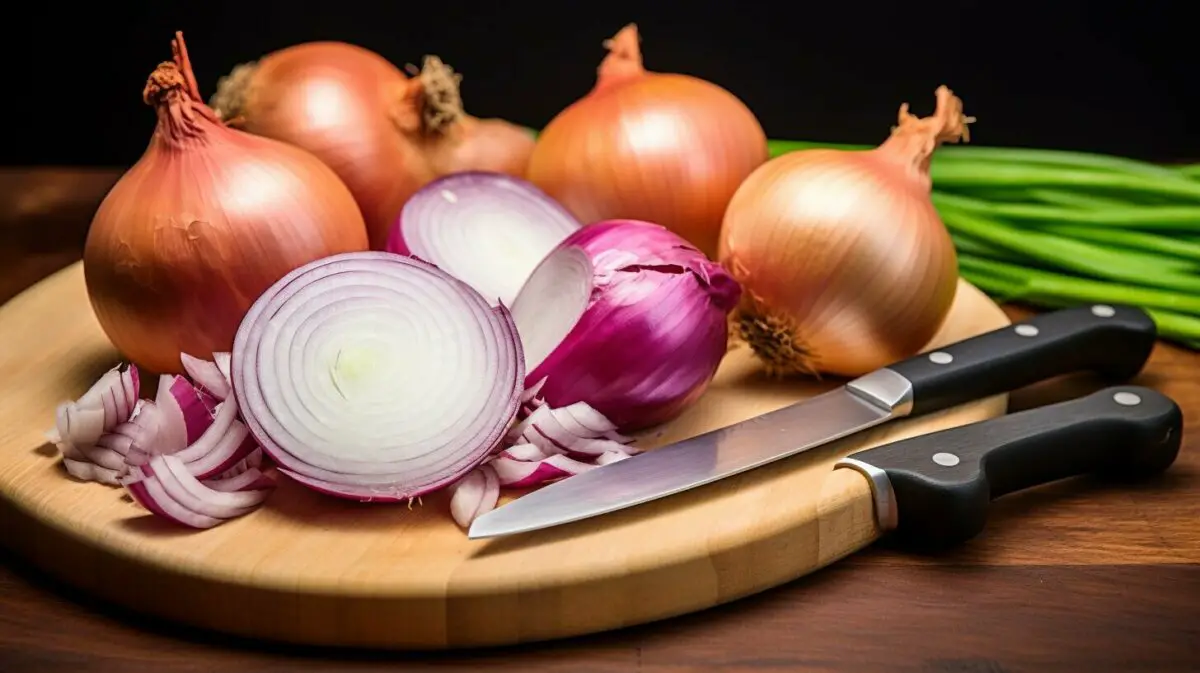
Adapting and adjusting onion chopping techniques allows you to customize your approach based on recipe requirements or personal preferences. Whether you need to substitute one type of onion for another, adjust the size of the onion pieces, or increase or decrease the quantity of onions in a recipe, having the knowledge of how to adapt your chopping techniques is key to achieving the desired results.
When it comes to substituting onions, it’s important to choose an onion variety that has a similar flavor profile and texture to the one called for in the recipe. For example, if a recipe calls for a sweet onion but you only have a regular yellow onion on hand, you can still achieve a similar taste by adjusting the cooking time and potentially adding a pinch of sugar to counterbalance the sharper flavor. Similarly, if a recipe calls for a red onion but you prefer the milder taste of a shallot, you can make that substitution as long as you adjust the quantity accordingly.
Adjusting Quantity and Size
A common scenario in recipe adjustments is needing to increase or decrease the amount of onions used. This can be done by simply halving, doubling, or modifying the quantity of onions based on personal preference or the desired outcome. If a recipe calls for a whole onion and you only need a smaller quantity, you can easily halve, quarter, or even dice the onion accordingly.
Furthermore, adjusting the size of the onion pieces can also make a difference in the final dish. For a more pronounced onion flavor, you can increase the size of the onion pieces, while smaller pieces will distribute the flavor more evenly throughout the dish. It’s all about finding the right balance based on the recipe and your personal taste preferences.
| Adjustment | Equivalent Quantity |
|---|---|
| Double | 2 times the original quantity |
| Halve | 1/2 of the original quantity |
| Third | 1/3 of the original quantity |
| Quarter | 1/4 of the original quantity |
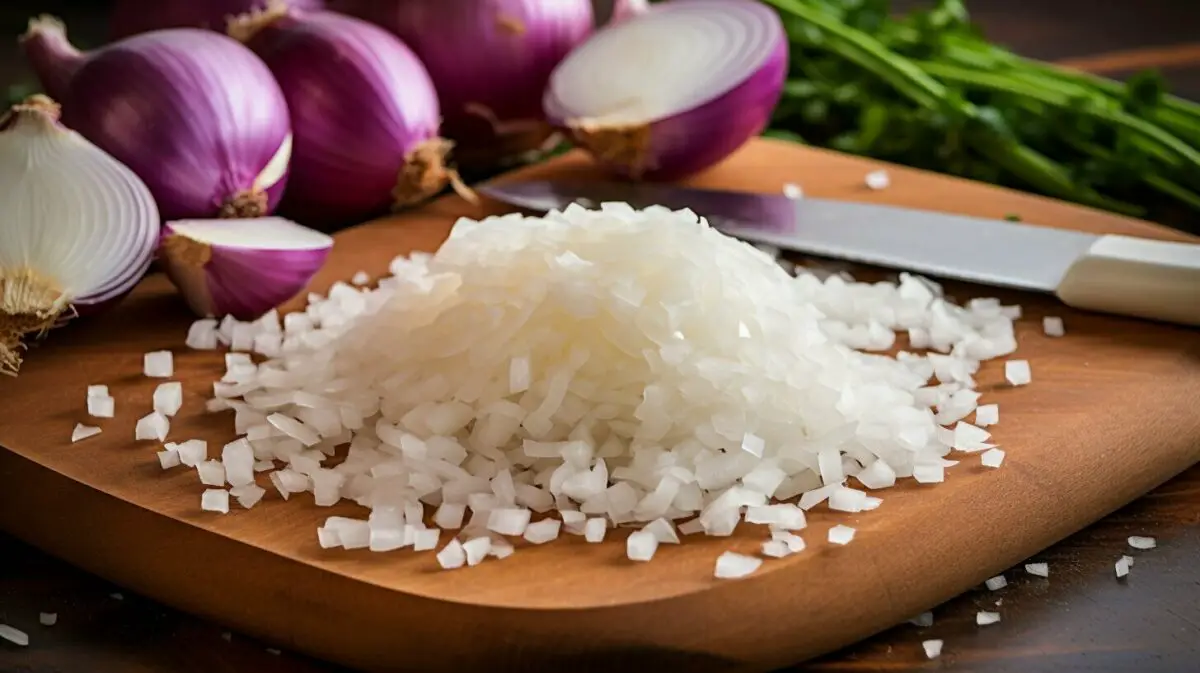
“Adjusting and adapting onion chopping techniques allows for flexibility in the kitchen, giving you the freedom to experiment and create dishes that suit your taste preferences. Don’t be afraid to make modifications based on what you have on hand or what you prefer. It’s all part of the joy of cooking!”
The Key to Chopping Onions with Precision and Consistency
Chopping onions with precision and consistency is the key to unlocking recipe success and achieving excellent flavor in your dishes. The way you chop an onion can greatly impact the taste and texture of your meals. To ensure that your chopped onions are uniform in size and evenly cooked, it is important to follow a few key techniques.
First, start by cutting off about 1/2 inch from the stem end of the onion and making a shallow cut off the root end. This creates a stable base for chopping. Next, cut the onion in half from top to bottom and peel back the onion skin. This exposes the layers of the onion, making it easier to chop.
Now, make lengthwise cuts into the onion, being careful to maintain control and stability. These lengthwise cuts serve as the foundation for the subsequent crosswise cuts. Hold the onion firmly and make vertical crosswise slices to create the desired shape, such as rings, half-moons, wedges, julienne, or brunoise. If you prefer a finer texture, you can also mince the onion by chopping it finely.

To avoid tears while cutting onions, it is recommended to use a sharp knife and minimize exposure to the cut sides of the onion. This can help reduce the release of tear-inducing sulfur compounds. Additionally, storing chopped onions in a zip-top bag or airtight container in the refrigerator can help extend their shelf life for up to 5 days.
By mastering the art of chopping onions with precision and consistency, you will enhance the visual appeal and taste of your dishes. So, sharpen your knife, follow these techniques, and become a pro at chopping onions!
Tips for Chopping Onions Like an Expert Chef
Want to chop onions like an expert chef? Take a cue from the professionals and incorporate their tips and tricks to up your onion chopping game. Whether you’re an aspiring home cook or a seasoned culinary enthusiast, these expert-approved techniques will help you achieve precision and efficiency in the kitchen.
“A sharp knife is your best friend when it comes to chopping onions,” says renowned chef and cooking instructor, Chef Johnson. Using a sharp knife not only makes the process easier but also helps in achieving clean and precise cuts. Invest in a good quality chef’s knife and sharpen it regularly to make your onion chopping experience a breeze.
Another valuable tip from the experts is to keep the exposure to the cut sides of the onion to a minimum. Chef Lisa advises, “When you cut an onion, it releases sulfur compounds that cause tears. To minimize this, make sure to cut the onion quickly and efficiently, and avoid lingering near the cut sides.” By reducing the exposure to the onion’s volatile compounds, you can significantly reduce tears and discomfort.
After mastering the art of chopping onions, you may find yourself with leftover chopped onions. To ensure the longevity of your prepped onions, store them properly. Place chopped onions in a zip-top bag or an airtight container and store them in the refrigerator. Chopped onions can typically be stored for up to 5 days, allowing you to easily incorporate them into your favorite recipes throughout the week.
| Expert Chef Tips for Chopping Onions |
|---|
| Use a sharp knife for clean and precise cuts |
| Minimize exposure to cut sides of the onion to reduce tears |
| Store chopped onions in a zip-top bag or airtight container in the refrigerator |
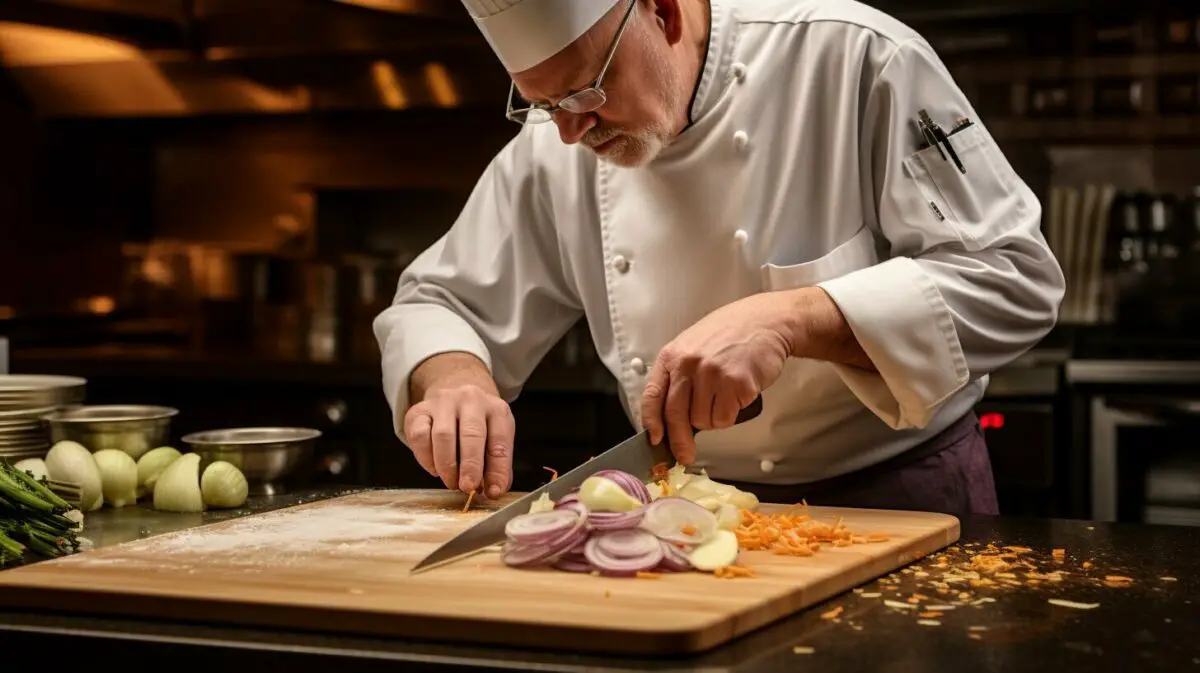
“To achieve uniform and consistent cuts, I recommend using the claw grip technique. Hold the onion with your non-dominant hand, making a claw shape by tucking your fingers and using your knuckles as a guide. This will help prevent accidental cuts and allow for precise control over the onion.”
By following these expert chef tips, you’ll be well on your way to chopping onions like a pro. So, grab your knife, put on your chef’s hat, and let the aromatic journey begin!
How to Chop an Onion – Conclusion
Congratulations! You are now equipped with the knowledge and skills needed to confidently chop an onion like a master chef. With the step-by-step guide provided, you have learned the importance of proper technique, the essential tools required, and the various cutting techniques to achieve different onion shapes. You have also discovered how to avoid tears while chopping onions and how to create a tear-free environment. Plus, you have gained insights into storing chopped onions and making conversions for your onion chopping needs.
By following these techniques and practicing regularly, you will refine your onion chopping skills and elevate your culinary creations. Remember, precision, accuracy, and consistency are key to achieving recipe success. Don’t be afraid to experiment and adapt the chopping technique to suit your specific needs or preferences. Whether it’s finely dicing onions for a delicate sauce or creating beautiful onion rings for a mouthwatering burger, your newfound skills will impress your friends and family.
So go ahead and embark on your onion chopping journey with confidence. Enjoy the process of transforming a humble onion into a delicious ingredient that adds flavor and texture to your favorite dishes. The more you practice, the more comfortable you will become, and soon you’ll be chopping onions like a pro. And for added convenience, remember to store your chopped onions in a zip-top bag or airtight container in the refrigerator for up to 5 days, ensuring they remain fresh and ready to use whenever you need them.
How to Chop an Onion – FAQ
Q: How do I chop an onion?
A: To chop an onion, first, cut off about 1/2 inch from the stem end and make a shallow cut off the root end. Then, cut the onion in half from top to bottom and peel back the onion skin. Make lengthwise cuts into the onion and then cross-wise cuts. Hold the onion firmly and make vertical crosswise slices. You can also mince the onion by chopping it finely.
Q: How can I avoid tears while cutting onions?
A: To avoid tears while cutting onions, use a sharp knife and keep the exposure to the cut sides of the onion to a minimum. This helps reduce the release of tear-inducing sulfur compounds. You can also try refrigerating the onion before chopping or chopping near a running fan for better ventilation.
Q: How long can I store chopped onions?
A: You can store chopped onions in a zip-top bag or airtight container in the refrigerator for up to 5 days. Proper storage helps maintain their freshness and flavor.
Our Friends:
Related Recipes:
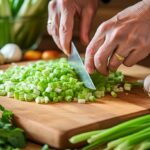 How to Cut Green Onions? (Step-By-Step Guide)
How to Cut Green Onions? (Step-By-Step Guide)
 How to Cut Shallots? (Perfect Step-By-Step Guide)
How to Cut Shallots? (Perfect Step-By-Step Guide)
 How to Cut a Tomato? (Perfect Step-By-Step Guide)
How to Cut a Tomato? (Perfect Step-By-Step Guide)
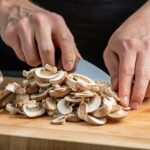 How to Cut Mushrooms? (Perfect Step-By-Step Guide)
How to Cut Mushrooms? (Perfect Step-By-Step Guide)
 How to Cut a Watermelon? (Perfect Step-By-Step Guide)
How to Cut a Watermelon? (Perfect Step-By-Step Guide)
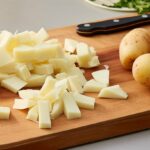 How to Cut Potatoes? (Perfect Step-By-Step Guide)
How to Cut Potatoes? (Perfect Step-By-Step Guide)
 How to Cut Dragon Fruit? (Perfect Step-By-Step Guide)
How to Cut Dragon Fruit? (Perfect Step-By-Step Guide)
 How to Cut Carrots? (Perfect Step-By-Step Guide)
How to Cut Carrots? (Perfect Step-By-Step Guide)







